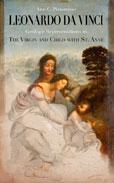
 |
Leonardo da Vinci: Geologic Representations in the Virgin and Child with St. Anne
by Ann C. Pizzorusso
Da Vinci Press
In her book of art history, Italian Renaissance scholar and geologist Pizzorusso examines Leonardo da Vinci's famed painting Virgin and Child with St. Anne. Estimated to have been painted between 1501 and 1517, the painting depicts a scene of Christ as a child clutching a sacrificial lamb while the Virgin mother reaches toward him. Meanwhile, her mother, St. Anne, glances upon them both. Pizzorusso examines the painting's mystique, which she says evokes a strong sense of "beauty, mystery and empathy."
As da Vinci studied the landscape particulars of the Alpine mountains in the Veneto, he recorded meticulous notations in his journals. Pizzorusso makes the case—providing ample visual and scientific evidence—that the Dolomites' specific topological features greatly influenced the natural settings employed in the work. Pizzorusso writes of "warm, earth-tone colors adjacent to the panoramic, majestic massifs," rendered in cool blues and grays. Further, agate and jasper rock formations are examined in the painting, as well as botanical analysis of the region and its representation in the da Vinci masterpiece.
Full of absolutely gorgeous glossy color photographs of the terrain in this northeastern range of the Alps, Pizzorusso's work is at once both scholarly and accessible to the layperson. Her descriptions of the majesty of these mountains are beautifully rendered. Divided by meadows, the land also features iconic isolated lakes formed over the centuries by melting glaciers—all features distinctive of the area. The author achieves excellence with highly detailed and engaging depictions both in the text (which in some parts reads quite like poetry) as well as through generous inclusion of visual representations, including photography and actual historical documentary notations and sketches of da Vinci himself.
RECOMMENDED by the US Review